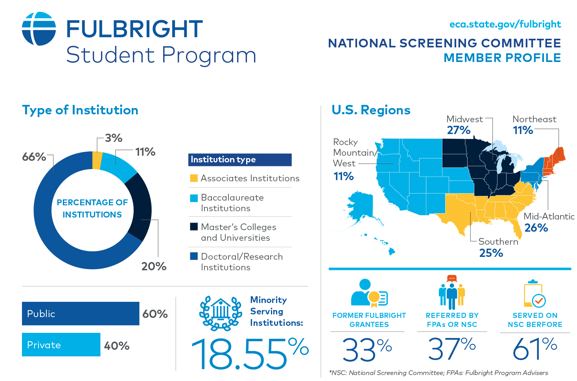Making the Grade: Five Things Every Applicant Should Know About the Fulbright U.S. Student Program Review Process
October 15, 2020By Fulbright Program Staff
Congratulations on submitting your Fulbright application! Now what? Have you ever wondered what happens to your Fulbright application after you hit “submit”? In this post, we’ll shed light on the Fulbright U.S. Student Program’s technical review and National Screening Committee (NSC) processes, illustrating how an applicant becomes a Fulbrighter.
1. First things first… Technical Review
After you hit “submit,” Fulbright Program staff first conducts a technical review of your application materials. Therefore, it pays to thoroughly review country descriptions and eligibility criteria at the beginning of your application journey to ensure that you meet all requirements. Check out our handy application checklist to make sure you don’t forget to include any application materials, too.
During our technical review, we double-check your biographical data, citizenship, transcripts, letters of recommendation, project plans, and more for eligibility and completeness. Make sure that ALL required materials are successfully uploaded and viewable in your online application portal—you won’t be able to add missing documents later! (Hint: Be sure to view and save a PDF copy of your application before submitting—you’ll have both a copy of your application for your records and be able to confirm that all documents are successfully submitted and readable!)
After confirming an application is eligible and complete, it is moved to the National Screening Committee (NSC) for review.
2. The NSC: The Reviewers (and What They Are Looking For)
During “NSC Season,” almost 200 committees meet to review and discuss all successfully submitted applications. Each application is sent to a committee of three reviewers a.k.a. NSC members, for a transparent, merit-based review process.
Who exactly are these reviewers? The individuals that review your application are typically university professors with expertise in either a) your academic/professional field, or b) the country or world region where you propose undertaking your Fulbright. Many are Fulbright alumni, while others have been recommended by Fulbright Program Advisers or other NSC members. Reviewers reflect the diversity of the U.S. higher education community and include panelists from minority-serving institutions (MSIs), Historically Black Colleges & Universities (HBCUs), and other underrepresented institutions.
Each committee reviews approximately 60-70 applications in advance of a meeting, scoring each submission based on specific review criteria. While all programs and applicants are unique, NSC reviewers look for well-researched, feasible research and community engagement projects, adequate academic and personal preparation for the proposed country or award, and personal attributes and qualities that illustrate a positive and passionate cultural ambassador of the United States to the world. Be authentically you!
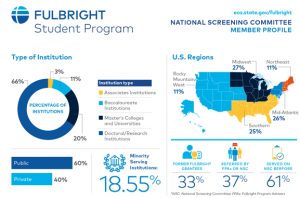
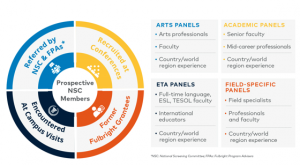
3. NSC Review Day
Throughout November and December, NSC reviewers gather for review meetings. Committees consist of three reviewers and one staff facilitator who directs the flow of the meeting, answers reviewers’ questions about the Fulbright Program, and records results. At these meetings, reviewers discuss each application using a collaborative approach and are welcome to adjust their scores based on their conversation. At the end of the meeting, final scores are tabulated by the staff facilitator, determining which candidates the committee recommends for further consideration during the host country review process.
4. Time & Consideration: The Breakdown
As you may have gathered, the NSC process is a massive undertaking! In 2019, 525 NSC members reviewed approximately 10,400 applications at 175 committee meetings in 6 different cities. From start to finish, more than 11,000 hours are spent screening, reviewing, and scoring each application. And that’s before the in-country review process!

5. The Decision
Based upon the NSC process, applications are designated as “Recommended” or “Non-Recommended.” All applicants are notified of their application’s status, and recommended applicants become “Semi-Finalists!” Recommended applications are forwarded to their respective Fulbright host countries for an additional round of selection, taking into account Fulbright Commission and U.S. Embassy priorities. During this period, Semi-Finalists undertaking research or graduate degree programs may be asked to submit letters of acceptance or affiliation from their proposed institution, so it’s important to receive all necessary documents as soon as possible. In some cases, host countries may also choose to contact Semi-Finalists for short phone or video chat interviews, in order to get a better sense of the person behind the application.
After months of concentrated effort by both applicants and Fulbright Program staff, host countries will share final application notifications on a rolling basis between February and May. Successful applicants are sent an award offer, and are officially known as “Finalists.” Qualified applicants not selected as Finalists may become “Alternates,” or potential awardees that may receive an award offer, should additional funding become available. Non-selected applicants are encouraged to celebrate their Semi-Finalist status, and reapply for the next award cycle. Even those who are not selected should feel extremely proud of their efforts, and know that many parts of the application can be applied to future endeavors beyond Fulbright, such as applying to graduate school.
The Fulbright U.S. Student Program application process is undoubtedly long. We hope this article provides some clarity into the process, and helps you create the best application you can. In writing, editing, and discussing your candidacy with friends, mentors, Fulbright Program Advisers, and other individuals, you may gain greater insight into your passions, your reasons for pursuing a Fulbright, other transferable skills you possess, and insight into our world. Our best wishes for a successful application and bright future!
How to Build a Fulbright Top-Producing Institution: University of Houston
May 22, 2020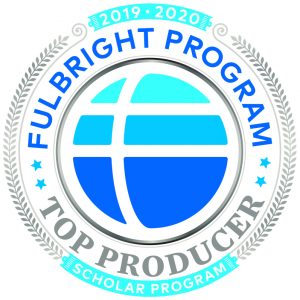
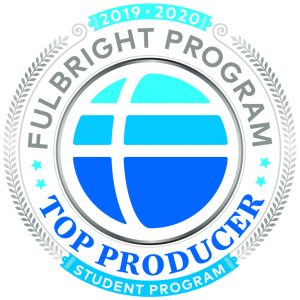
What makes a “Fulbright Top-Producing Institution“? In the coming weeks, a variety of institutions will discuss their efforts to recruit, mentor, and encourage students and scholars to apply for the Fulbright U.S. Student and U.S. Scholar Programs. We hope these conversations pull back the curtain on the advising process, and provide potential applicants and university staff with the tools they need to start their Fulbright journey.
By Ben Rayder, Director of National Fellowships and Major Awards at University of Houston
Question: Your outstanding students are one of many factors that led to this achievement. What makes your students such exceptional candidates for Fulbright grants?
The students at the University of Houston (UH) are hardworking and reflect Houston’s incredible diversity. They bring real-life experience to their applications, whether they are working part-time to pay their tuition or are the first in their family to attend college. They also represent the many ways in which one can be an American. The University of Houston is the 5th most diverse school in the country, so our applicants are invariably some of the best representatives of the United States. I am constantly motivated to support these candidates and I believe that they inspire others with their stories.
What steps have you taken to promote a Fulbright culture on your campus?
Each year we kick off the new application cycle with a Fulbright Day and invite the IIE office in Houston to participate. This gives future candidates an initial opportunity to learn more about the program and pose application-related questions to a panel of Fulbright finalists who have not yet departed on their grants. I prefer that our candidates receive a student perspective in addition to everything that I have to share. I also send targeted emails to communications directors, faculty, department chairs, and others to spread the word about the Program. At a school of 46,000 students, building relationships with faculty and staff is important in order to reach as many students as possible.
How has your institution benefited from increased engagement with the Fulbright Program (reaching campus internationalization goals, international expose for your campus, etc.)?
One of the ways that UH has benefited the most from increased engagement with Fulbright is through faculty participation in National Selection Committees (NSC). After serving on NSCs, our faculty have a much better sense of the selection criteria and what makes for a strong candidate. Although these factors obviously vary by country, their experiences have helped immensely in informing the advising process and in conducting campus committee interviews. I encourage all FPAs to promote this opportunity to faculty, serve themselves, or observe an NSC.
Your advisory team of faculty and staff (FPA, Liaison, etc.) provided exceptional guidance throughout the rigorous Fulbright application process. What does this process look like on your campus, and what are some of the most important pieces of advice you give your Fulbright applicants?
At UH, I collaborate with a faculty liaison in the Honors College, Richard Armstrong, to organize campus committee interviews and advise students. His connections with faculty make it possible to populate committees with relevant and committed faculty from across campus. In the weeks leading up to the national deadline, we ask selected faculty who participated in the campus committee interviews to provide some final feedback to our candidates, since it can be a challenge for one FPA to advise dozens of applicants alone.
In addition to the customary pieces of advice that we give applicants (show, don’t just tell; explain how Fulbright fits into your larger trajectory; etc.), we encourage them to own the regional diversity that they bring to the program. As an NSC member and Fulbright alumnus, I can always appreciate when a student talks about how they will incorporate some regional flavor into their teaching lessons or research. People abroad are genuinely curious about Texas. Most of our students have grown up here and can speak to the nuances and stereotypes that are likely to make for great cultural exchange opportunities.
What advice do you have for other universities & colleges that want to increase the number of Fulbrighters produced by their institution?
Start recruiting early and celebrate success. The fellowships profession is no longer a cyclical one. Even before the majority of semi-finalists have been notified and the application portal has opened, I have already started to develop marketing materials, contact liaisons across campus, and promote Fulbright Day to students. In some cases, I am advising students on personal statements and statements of grant purpose in February. I am fortunate in the sense that many of our students live in the Greater Houston Area and can visit over the summer. However, this is not the case for many of my colleagues in the profession. Students naturally become distracted with other opportunities over the summer months, so it is helpful when I can identify candidates and start them on their applications in the spring.
This is the first time that the University of Houston has been named a Fulbright Top Producing Institution. In the previous three years, our total number of applicants has more than tripled and our total number of recipients has increased six-fold. The potential has always been there, but we needed some success stories to create more momentum for Fulbright at UH. Even before we reached Top Producing status, we celebrated every recipient and the benefits of applying for a major award. Word of mouth goes a long way. As more prospective candidates have seen their peers applying for and receiving Fulbright awards, we have seen the emergence of a tangible culture of success.

